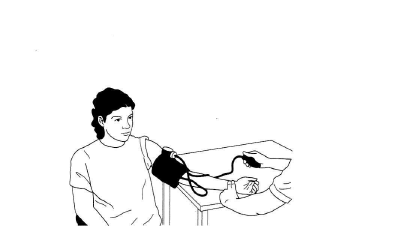| Description: |
- Client sit and rest in a chair with arm rests or with left arm on table
- Feet should be flat on the floor
- Rest for 5 minutes – this can happen while you build a rapport, ask discovery questions, complete RHR assessment
- Choose an appropriately sized cuff for the client
- Place the cuff on the bare left upper arm, 2-3 cm above the antecubital space
- The lower edge of the cuff should be approximately level with the heart
- The cuff should be tight enough so that two fingertips can be slipped under the top edge
- If possible, palpate brachial artery and ensure arrow on cuff lines up
- Find radial pulse with one hand
- With the other hand, rapidly inflate cuff until you no longer feel radial pulse
- Inflate cuff 20-30 mmHg above that point
- With ear pieces pointing forward, put stethoscope in ears, and put diaphragm over brachial artery
- Ensure diaphragm of stethoscope is in complete contact with skin, not touching cuff or tubing
- Release pressure slowly (2 mmHg/second)
- Record Systolic blood pressure to the nearest 2 mmHg – the first perception of sound as the pressure drops
- blood is now passing through upper arm
- Record Diastolic blood pressure to the nearest 2 mmHg – the sounds becomes muffled (from tapping)
If the SBP is >144 mmHg or the DBP is >94 mmHG wait an additional five minutes and retake reading
If the SBP is >160 mmHg or the DBP is > 90 mmHg after the second reading consider sending your client to a Physician prior to having them engage in physical activity. Note, hypertension is defined as 140 mmHg / 90 mmHg.
|

